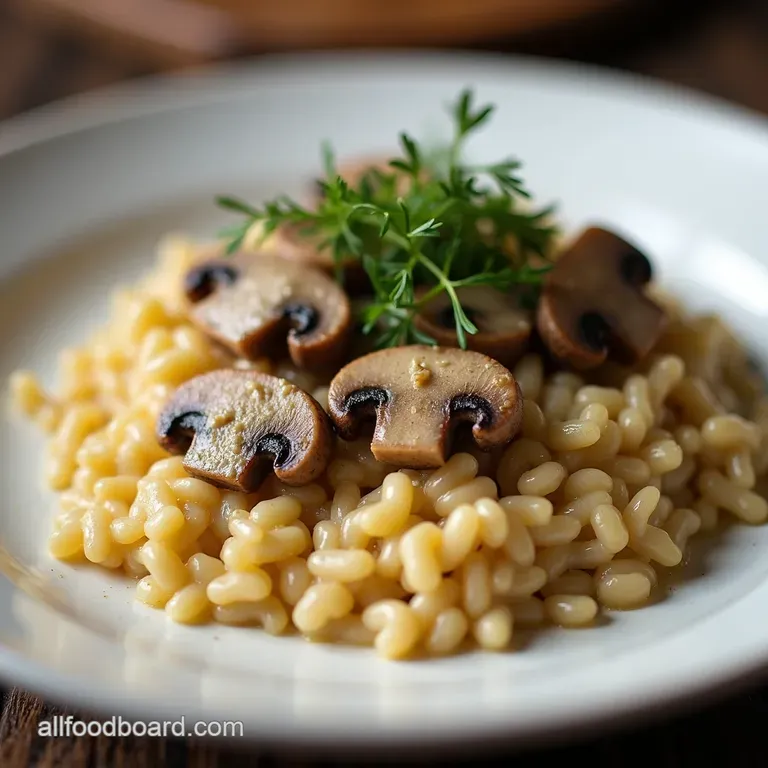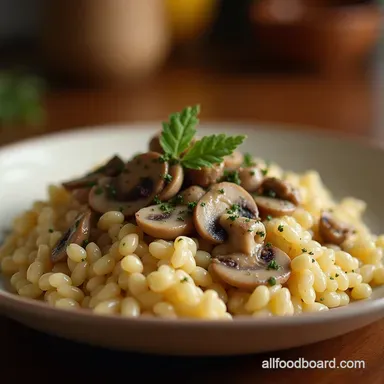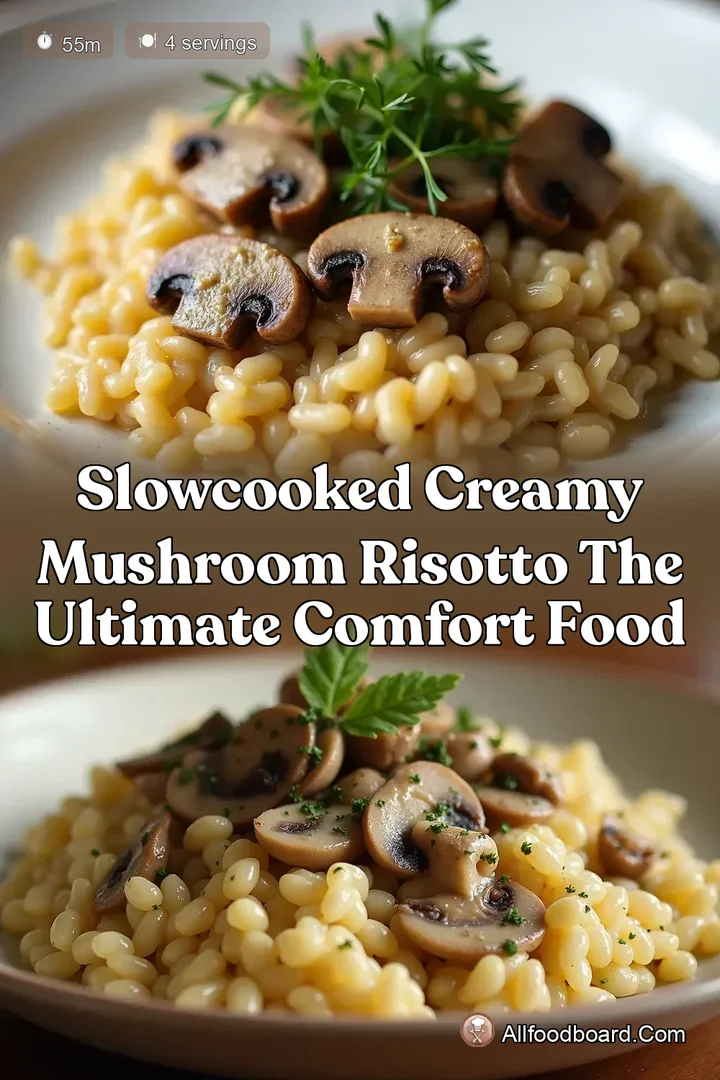Creamy Mushroom Risotto The Sunday Lunch Showstopper

Creamy Mushroom Risotto Gold

Ingredients:
Instructions:
Nutrition Facts
Unlocking True Italian Comfort: Why This Risotto Stands Apart
There is a magic that happens when simple ingredients are transformed through patience and technique, and nowhere is this more evident than in a perfect plate of risotto. Forget the rushed, gluey imitations you might have encountered; this Creamy Mushroom Risotto recipe is designed to transport you straight to a bustling Lombard kitchen. It’s a testament to slow cooking, where the starch of the rice grain is coaxed out, releasing a velvety sauce that coats every bite. This isn't just dinner; it's an act of culinary love, resulting in a Homemade Mushroom Risotto Dinner that feels both deeply rustic and elegantly refined. We aim for that elusive, flowing consistency that Italians call all'onda —a wave—and with the right approach to the grains and liquids, you’ll achieve it every time.
The Soul of Saffron and Earth: Defining Our Creamy Mushroom Risotto
This particular Creamy Mushroom Risotto Recipe leans heavily into the earthy, umami richness provided by a medley of fungi. While saffron often defines classic risotto Milanese, here, the spotlight shines on the deep, savoury notes of sautéed mushrooms, complemented by quality stock and the sharpness of aged cheese. The result is a Healthy Vegetarian Risotto Dish (if vegetable stock is used) that is hearty enough to satisfy the most ardent meat-eater, yet delicate enough for a sophisticated evening meal.
Beyond Basic Rice: The Promise of Slow-Stirred Perfection
The foundation of any great risotto lies in the rice itself—specifically, high-amylopectin short-grain varieties like Arborio or, ideally, Carnaroli. Unlike long-grain rice, these grains release their starch slowly and consistently when agitated, creating the binding, luxurious texture that defines this dish. The commitment to stirring isn't merely tradition; it is the physical mechanism by which we achieve that signature, cohesive texture, ensuring every grain is tender on the outside while retaining a firm, satisfying bite at its core, the definition of al dente .
Why This Recipe Masterfully Handles Mushroom Flavour
To achieve maximum depth, we employ a two-stage mushroom process. We begin by vigorously sautéing a generous pound of mixed Cremini, Shiitake, and Oyster mushrooms until they caramelize and brown deeply. Crucially, we then remove about half of these cooked mushrooms before proceeding with the rice base. This ensures that when we later incorporate them during the final stages, we retain some textural integrity, preventing everything from dissolving into a single mushy mass. This technique honours the flavour of the fungi while providing textural contrast within the overall Creamy Mushroom Risotto Recipe Easy .
Setting the Scene: What Makes This Dish a Showstopper
This Easy Homemade Risotto Dinner shines because of its balance. The richness from the butter and Parmesan (the mantecatura ) is perfectly offset by the slight acidity introduced by the dry white wine used to deglaze the pan. Coupled with the deeply earthy base, it presents a complex flavour profile that justifies the 55-minute total time commitment. It’s a substantial main course that feels incredibly rewarding to produce.
Related Recipes Worth Trying
- Easy Marry Me Chicken Meatballs in Creamy Sauce Recipe — Get the romantic flavour of Marry Me Chicken in tender meatballs This easy recipe cooks quickly in a sundried tomato cream sauce Perfect with pasta or orzo
- The No Fuss Spinach Mushroom Cottage Cheese Crustless Quiche — Skip the pastry This foolproof Spinach and Mushroom Cottage Cheese Crustless Quiche is packed with protein and flavour for the perfect brunch or light...
- The Glacial Glimmer Snowflake Martini Creamy Easy — Looking for sophisticated Winter Holiday Cocktails This Easy Snowflake Martini Recipe blends vodka white chocolate and coconut for a frosty sip
Assembling the Pantry for Superior Flavour Development

Successfully executing this dish, whether you aim for a Quick Mushroom Risotto (which is relative, as risotto cannot truly be rushed!) or a leisurely Sunday preparation, starts with selecting excellent raw materials. Low-sodium stock, aromatic alliums, and high-quality cheese are non-negotiable components that dictate the final quality of your Creamy Mushroom Risotto .
Choosing Your Fungi: Wild vs. Cultivated Mushroom Selection
For the best experience in this Creamy Mushroom Risotto with Heavy Cream (though our recipe achieves creaminess without the heavy cream, relying on starch emufication), utilize a blend. Cremini offer reliable body, Shiitake add smokiness, and Oyster mushrooms provide a delicate, almost silken texture. If you can source dried porcini, rehydrate them separately; strain the resulting liquor and add that dark, potent liquid into your main stock for an incredible umami boost.
The Crucial Role of Stock and Wine in the Base
The stock—whether chicken or vegetable—must be kept simmering gently throughout the entire cooking process. Adding cold liquid shocks the rice, halting starch release and resulting in unevenly cooked grains. On top of that,, the white wine (a dry Pinot Grigio is excellent) performs a vital function: it cleanses the palate slightly and introduces acidity that cuts through the fat, ensuring the final dish isn't cloyingly rich.
Parmesan Power: Selecting the Right Hard Cheese for Finish
Do not substitute pre-grated, shelf-stable Parmesan. For the final mantecatura , you require authentic, aged Parmigiano-Reggiano, freshly grated. This hard cheese contains the necessary crystalline structures and flavour compounds that melt perfectly into the rice emuon. It brings salinity, nuttiness, and that final layer of savoury depth required for truly authentic Mushroom Risotto Recipes .
The Al Dente Ascent: Mastering the Risotto Technique
The technical heart of this recipe lies in the gradual incorporation of liquid. This slow, rhythmic process is what separates a passable rice dish from transcendent Creamy Mushroom Risotto .
The Toasting Trick: Preparing the Arborio Grains
After your shallots and garlic have softened, add the dry Arborio rice to the hot fat. This step, known as tostatura , is essential. Stir the grains continuously for two to three minutes until their edges turn translucent and they smell faintly nutty. This brief heating seals the outer layer of the grain, ensuring it absorbs liquid slowly and retains its central core firmness even as the exterior softens into creaminess.
Ladling Technique: The Art of Gradual Stock Incorporation
Once the wine has evaporated, the slow work begins. Add your hot stock one ladleful at a time, ensuring the rice is almost dry before the next addition. Stirring should be constant but gentle—enough to keep the grains moving against each other to release starch, but not so vigorous that you break the grains apart. This patient cycle of absorption and stirring is the defining characteristic of making a truly Creamy Mushroom Risotto .
Achieving the Signature 'All'Onda' Wave Consistency
After about 20 to 25 minutes of stirring and stock additions, taste the rice. It should yield tenderly yet retain a slight resistance when bitten (al dente). If you spread a spoonful across a plate, it shouldn't sit in a stiff mound; it should slowly spread out in a gentle, flowing wave— all'onda . This visual check confirms you are ready for the final crucial step.
The Final Mantecatura: Whipping in Fat for Ultimate Creaminess
This final, swift action defines the texture. Remove the pan entirely from the heat source. Immediately, whip in the cold cubes of unsalted butter and the grated Parmesan cheese. Stir vigorously, incorporating air and emufying the starch with the fat. This off-heat action is key; it transforms the mixture from loose rice into the cohesive, glossy sauce characteristic of the finest Creamy Mushroom Risotto .
Troubleshooting and Tips for Unbeatable Results
Even expert cooks can face minor setbacks, but knowing how to adjust mid-stream guarantees success for your Creamy Mushroom Risotto Dinner .
If your risotto seems too tight or dry during the stirring process, don't panic. Simply add half a ladle of warm stock and stir it in completely before assessing again. Conversely, if you’ve finished cooking and it seems too soupy, you can return it briefly to very low heat for one minute, stirring constantly, just before the mantecatura stage, to absorb a touch more liquid. Remember, the final texture should be slightly looser than you think, as it will firm up marginally as it rests before serving.
Storage Secrets: Reheating Risotto Without Losing Texture
Authentic risotto is best eaten immediately, but leftovers can be revived. To reheat, place the leftover risotto in a saucepan and mix in a splash of fresh stock or water for every cup of rice. Heat gently over low heat, stirring constantly until it loosens back into its creamy state. Avoid microwaving, which tends to dry out the grains excessively.
Variations on the Theme: Herb and Spice Customisations
While this recipe focuses on the mushroom profile, you can introduce complexity. A pinch of smoked paprika added during the toasting of the rice grains adds wonderful warmth. Alternatively, folding in finely chopped chives or tarragon during the mantecatura offers a fresh, herbaceous lift that contrasts beautifully with the earthiness of the fungi.
Pairing Perfection: Wine Suggestions for This Rich Dish
The ideal accompaniment mirrors the wine used in the cooking process. A crisp, unoaked white wine like a Vermentino, Gavi, or even a dry Prosecco will refresh the palate after each rich bite of the Creamy Mushroom Risotto . If you prefer red, choose something light-bodied with low tannins, such as a chilled Beaujolais or a light Pinot Noir, to avoid clashing with the dairy and mushrooms.
Frequently Asked Questions About Risotto Making Myths
Many people believe that adding cheese is the source of creaminess. While Parmesan adds flavour and body, the actual creamy texture is derived solely from the friction and starch release during the slow, patient stirring process, enhanced by the final cold butter emuon. Another myth is that rinsing the rice helps—as discussed, rinsing removes the essential surface starch needed for this specific dish. Stick to the slow-ladle technique, and you will master this Creamy Mushroom Risotto Recipe Easy .

Recipe FAQs
Why does my Creamy Mushroom Risotto turn out gummy instead of flowing nicely (all'onda)?
This usually happens if you stir too violently or add too much liquid all at once, which breaks down the starches too quickly. Remember, the key to that signature creamy flow is the gentle, constant stirring off the heat during the mantecatura (step 9) with the cold butter and Parmesan. Don't rush that final emufication process!
Can I use dried mushrooms in this recipe, and how should I prepare them?
Absolutely, dried mushrooms, especially porcini, add an incredible depth of flavour—it’s the secret weapon of many Italian cooks! Soak about 1/2 oz in hot water for 30 minutes, strain the mushrooms (reserving the soaking liquid), chop them up, and add them in with your fresh ones. Just be sure to strain that soaking liquid very carefully and add it to your stockpot to keep that savoury boost.
How long can I store leftover Creamy Mushroom Risotto, and is reheating tricky?
Risotto is best eaten fresh, within an hour of making it, as it tightens up considerably when cooled. If you must store it, keep leftovers in an airtight container in the fridge for up to 2 days. To reheat, don't microwave it straight away—stir in a splash of fresh hot stock or water over medium heat, stirring constantly until it loosens up and reabsorbs the liquid nicely.
I don't have Arborio rice; what is the best substitute for making this risotto work?
For authentic results, you really want a high-starch, medium-grain Italian rice like Arborio or the slightly superior Carnaroli—they release starch perfectly for that creamy texture. If you’re absolutely stuck, Carnaroli is the best swap; however, avoid long-grain varieties like Basmati or Jasmine, as they won't break down correctly and will just end up tasting like slightly wet rice pudding.
Do I really need to keep the stock constantly simmering on the hob?
Yes, you really do; it’s one of those non-negotiable bits of culinary housekeeping for risotto! Adding cold stock will shock the rice grains, stopping the starch from releasing evenly, which ultimately ruins that smooth, velvety texture we are aiming for. Think of it like brewing a perfect cup of tea—you need the water hot enough for the magic to happen!